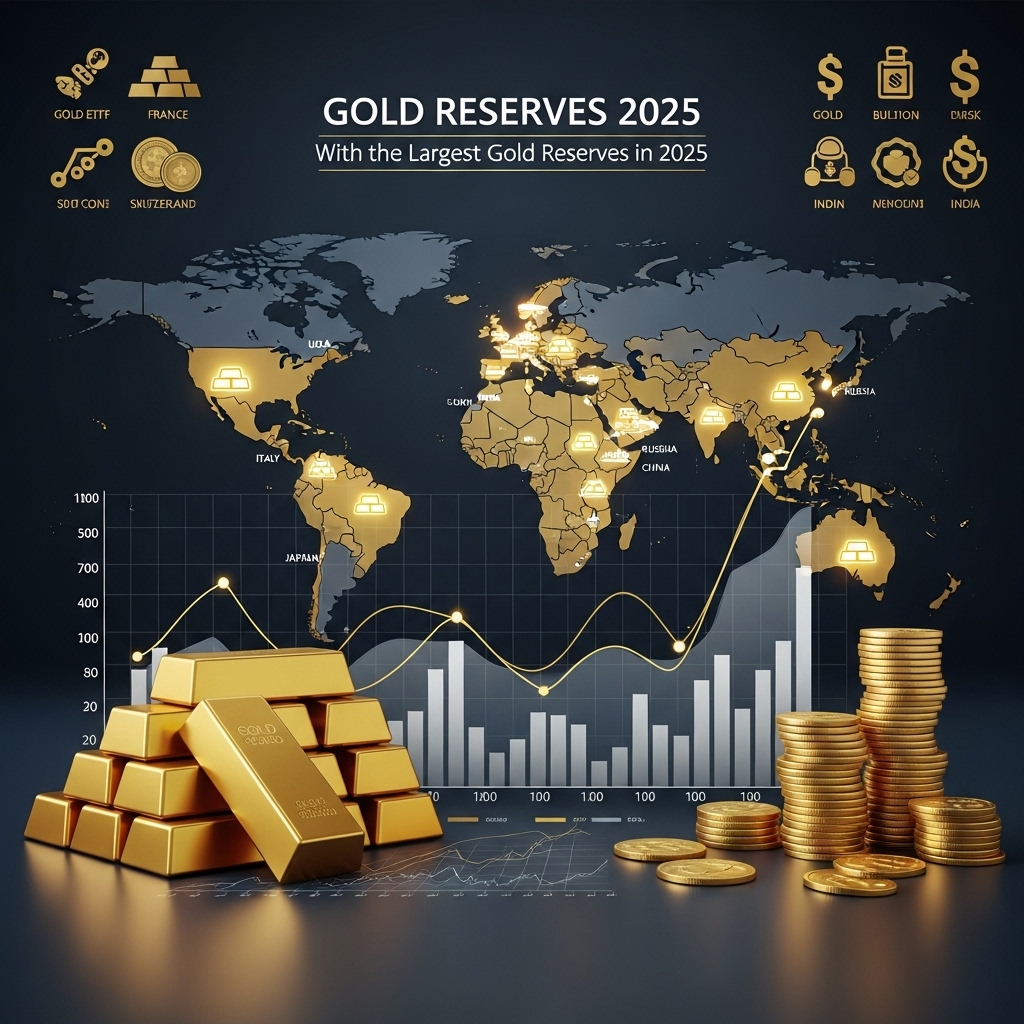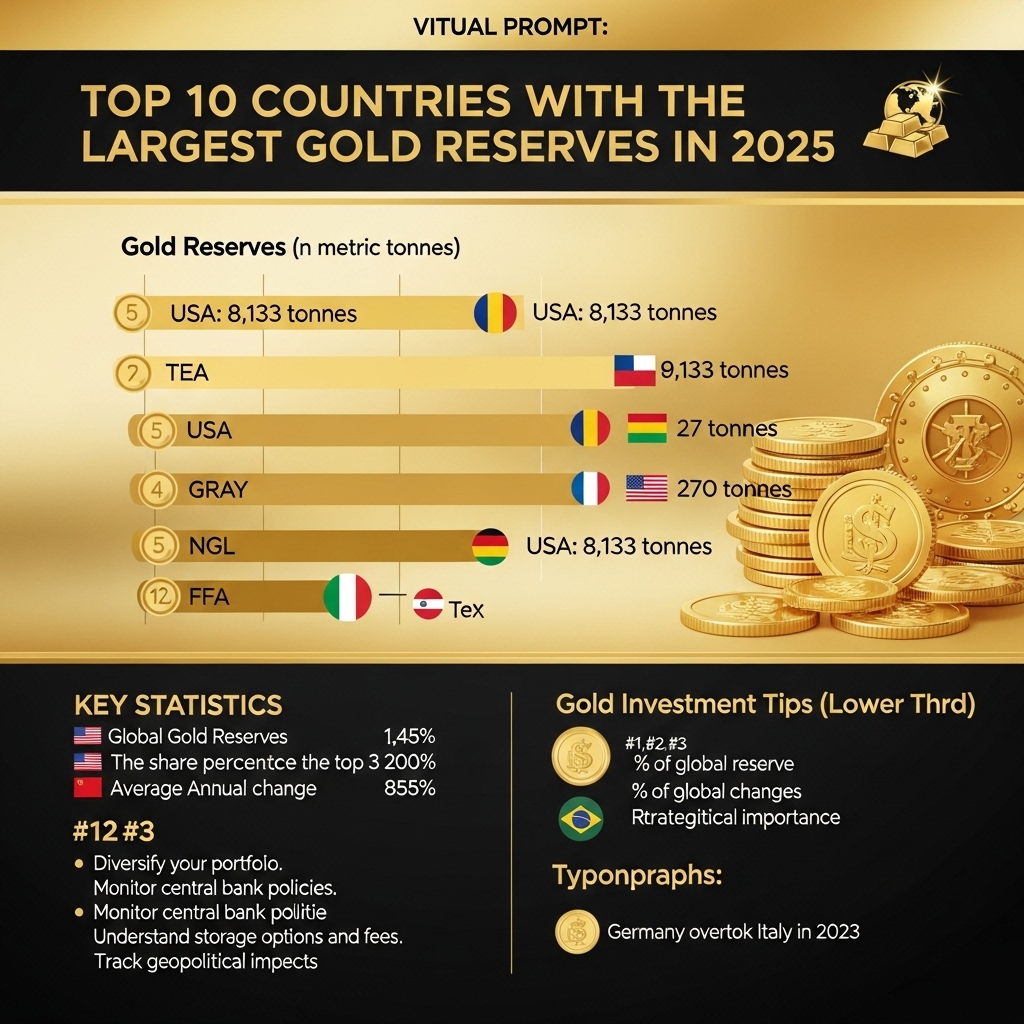Introduction & Overview: Exploring the World’s Biggest Gold Reserves in 2025
Gold has long stood as a beacon of wealth, stability, and opportunity for investors worldwide. In today’s climate of economic uncertainty, inflation concerns, and shifting geopolitical tensions, the allure of gold has only intensified. With prices surging to near-record highs in the first half of 2025 and central banks diversifying their assets, understanding the dynamics behind gold reserves has never been more crucial.
In this post, we’ll unveil the top 10 countries boasting the largest official gold reserves in 2025. You’ll discover which nations are leading the global rankings, how their reserve strategies impact the gold market, and what these trends mean for private investors. By examining new data and recent developments, we’ll shed light on how these reserves shape both national economies and global market sentiment.
For gold investors—whether you’re a seasoned trader or just starting out—knowing where the gold sits (and why) can inform smarter investment strategies. Countries with massive reserves play a pivotal role in price stability and can signal broader economic shifts. So, if you’re seeking a deeper understanding of the gold market’s future or looking for fresh insights to guide your portfolio, read on as we explore the 2025 gold reserve powerhouses and what their holdings mean for your next investment move.
Gold Market Analysis and Key Insights
Record Gold Reserves Amid Global Uncertainty
In 2025, the world’s top 10 countries—led by the United States, Germany, Italy, France, and Russia—are holding record-high gold reserves, collectively surpassing 34,000 metric tons. Central banks have increased their gold acquisitions, driven chiefly by geopolitical tensions, economic uncertainty, and persistent inflation. According to World Gold Council data, central bank gold purchases rose by over 15% year-on-year in the first half of 2025, signaling continued faith in gold as a strategic asset.
Market Trends Fueling Gold Investment
Gold prices have soared to historic highs, with spot rates touching $2,350 per ounce in early 2025. Weakness in major currencies and volatile stock markets are encouraging both institutional and retail investors to look toward gold as a safe haven. Notably, China—increasing its reserves at the fastest pace—seeks to reduce reliance on the U.S. dollar, further boosting global demand. Exchange-traded funds (ETFs) and sovereign wealth funds in key gold-holding nations report record inflows, underlining rising investor appetite.
Investment Benefits and Considerations
Benefits:
Gold remains a proven hedge against inflation and currency devaluation. Its traditional role as a portfolio diversifier becomes more pronounced during periods of economic stress. With central banks setting a floor under gold demand, private investors benefit from a more stable outlook and potential for long-term capital appreciation.
Considerations:
Gold investment, however, is not without risks. It generates no income, making its appeal sensitive to shifts in real interest rates. Price volatility driven by macroeconomic policies or speculative trading can also impact short-term returns. Investors should be wary of overexposure and consider costs related to storage or ETFs.
Expert Recommendations
Analysts advise a balanced approach, allocating 5–15% of portfolio assets to gold, depending on risk tolerance and market outlook. Diversifying through a mix of physical gold, ETFs, and gold mining equities is recommended. With central bank buying set to continue and economic uncertainty persisting, experts suggest maintaining core gold holdings as a key element of strategic asset allocation throughout 2025.

Gold Investment Strategies and Options
Investing in gold remains a favored strategy within the world’s largest gold-holding countries, offering a hedge against inflation, geopolitical uncertainty, and currency fluctuations. Investors can choose from various gold investment vehicles, each with unique benefits and considerations.
Physical Gold: Purchasing gold bullion (bars and coins) is the most traditional route. It offers direct ownership and zero counterparty risk, but incurs storage, insurance, and liquidity concerns.
Gold Exchange-Traded Funds (ETFs): Gold ETFs track gold prices and provide easy market access without the hassle of handling physical metal. They are highly liquid, suitable for active trading or long-term holdings, and often come with lower transaction costs than physical gold.
Mining Stocks and Mutual Funds: Investing in mining companies or gold-focused mutual funds offers exposure to the sector’s growth. However, such stocks are subject to operational risk, market volatility, and management decisions, which can diverge from gold’s price movements.
Futures and Options: For sophisticated investors, gold futures and options provide leveraged exposure. While the potential for high returns exists, so does a heightened risk of significant losses, making these instruments suitable primarily for experienced traders.
Risk Assessment and Portfolio Allocation: Gold is best used as a diversification tool. Most advisors recommend a portfolio allocation of 5–15% in gold, depending on individual risk tolerance, investment goals, and macroeconomic outlook. Overexposure can reduce portfolio returns when equity markets outperform, while too little exposure may fail to provide the desired hedge.
Investment Method Comparison: Physical gold offers tangibility but less convenience. ETFs and mutual funds enable easy diversification and liquidity. Mining stocks carry higher volatility, and derivatives demand active monitoring and risk controls.
Market Timing Considerations: Global macroeconomic trends, interest rate shifts, and central bank policies in top gold-reserve nations can impact gold prices. Rather than timing the market, dollar-cost averaging and periodic reviews generally produce superior long-term results, minimizing emotional investment decisions.
Market Performance and Outlook
Historically, gold has maintained its status as a safe-haven asset, with central banks across the globe steadily increasing their reserves over the past decade. The top 10 countries with the largest gold reserves, led by the United States, Germany, and Italy, collectively hold over 60% of all official global holdings. Between 2015 and 2023, gold prices surged by nearly 70%, driven by economic uncertainties, geopolitical tensions, and robust central bank demand—especially from emerging economies like China and Russia.
Entering 2025, the gold market remains resilient. Prices have largely fluctuated between $1,900 and $2,200 per ounce in the previous year, buoyed by persistent inflation concerns and global shifts in monetary policy. Central banks, particularly in Asia and the Middle East, have continued ramping up gold purchases to diversify reserves away from the US dollar and hedge against volatility.
Looking ahead, the outlook for gold remains constructive. Analysts predict that ongoing geopolitical risks, potential economic slowdowns, and currency fluctuations will keep gold demand elevated. Macroeconomic factors—such as interest rate movements, inflation trends, and US dollar strength—will continue to exert a significant influence on prices. Should central bank buying remain strong and inflation persist above targets, gold prices could potentially breach new highs. Overall, gold’s strategic role within national reserves is set to strengthen in the face of evolving economic landscapes.
Frequently Asked Questions About Gold Investment
Which countries have the largest gold reserves in 2025?
As of 2025, the top countries with the largest gold reserves typically include the United States, Germany, Italy, France, Russia, China, Switzerland, Japan, India, and the Netherlands. These rankings may shift slightly year-to-year based on central bank activities.
Why do countries hold gold reserves?
Countries hold gold reserves as a form of financial security. Gold acts as a hedge against inflation, currency fluctuations, and economic crises. It also boosts confidence in a nation’s monetary stability and creditworthiness.
How does a country’s gold reserve affect its economy and currency?
Large gold reserves can strengthen a country’s financial position, stabilize its currency, and enhance its credit rating. They also provide governments and central banks with flexibility during economic downturns or geopolitical tensions.
Is investing in gold a safe choice for individuals?
Gold is often considered a safe-haven investment, especially during market volatility or inflation. However, like all assets, it carries risks such as price fluctuations, and should be balanced with other investments.
How can I invest in gold besides buying physical metal?
Besides purchasing coins or bullion, investors can consider gold ETFs, mining stocks, futures contracts, and gold-backed mutual funds. Each option carries unique risks and advantages regarding liquidity, ownership, and volatility.

Final Thoughts on Gold Investment
In summary, understanding the world’s top gold-reserve countries—like the United States, Germany, Italy, and China—provides valuable insight into global economic trends and gold’s enduring importance as a safe-haven asset. For gold investors, these rankings highlight the strategic confidence central banks place in gold, bolstering its role in portfolio diversification and wealth preservation. As global uncertainties persist throughout 2025, allocating a portion of your portfolio to gold remains a prudent decision. We recommend staying informed about macroeconomic shifts and considering both physical gold and gold-backed securities for diversified exposure. Ready to take your investment strategy to the next level? Explore our gold investment resources, stay updated with market news, and consult with a financial advisor to craft a plan aligned with your goals. Start securing your financial future with gold today!